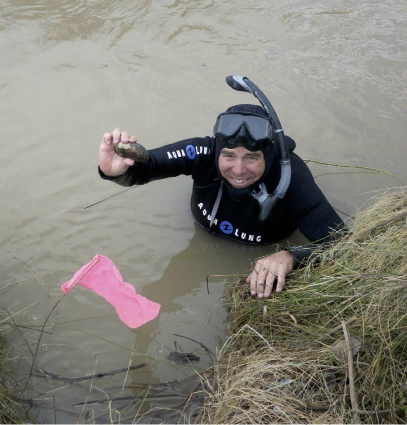
David J. Berg
Contact Info
Biographical Information
Research in the Aquatic Biodiversity & Conservation (ABC) Laboratory focuses on the evolution and conservation of biodiversity, and the geographic distribution of this diversity across freshwater ecosystems. Our study organisms include amphipods, snails, and other invertebrates inhabiting springs in the Chihuahuan and Great Basin deserts, and freshwater mussels (the most imperiled group of animals in the United States) from throughout North America. The evolutionary forces we study are natural selection, isolation and dispersal among populations, and random changes in genetic diversity and community composition. Desert springs provide ideal systems for this work because they contain unique assemblages of invertebrates. In fact, we recently described four new species within the amphipod genus Gammarus from these ecosystems. Stark landscapes, wide-open spaces, and beautiful sunsets are added bonuses for working in this part of the world.
Our work with freshwater mussels has focused on the geographic distribution of genetic diversity within species. We are interested in understanding the mechanisms by which populations of mussels re-inhabited northern rivers following the recessions of Pleistocene glaciers. We also are estimating the degree of gene flow among declining populations when isolation of such populations becomes greater due to habitat fragmentation, climate change, and other anthropogenic causes.
In addition to basic research, we are using genomic tools to answer questions of conservation interest. The National Science Foundation has funded our surveys of desert springs to uncover cryptic biodiversity: new species that are genetically distinct from, but outwardly similar to, known species. Because most of our study organisms are at risk of extinction – largely due to human alteration of habitat – our research is of interest to agencies and organizations that manage endangered species. The U.S. Fish and Wildlife Service, the Bureau of Land Management, the New Mexico Department of Game and Fish, the World Wildlife Fund, and other agencies and NGOs provide funding for research that informs their efforts at conservation. Our research has provided critical information leading to decisions to list four species of invertebrates under the US Endangered Species Act.
We use next-generation sequencing tools for investigating the population genomics, evolution, and distribution of diversity in target organisms.This approach genotypes organisms at thousands of loci per individual via the use of Restriction site-Associated DNA Sequencing (RADseq) and Ultraconserved Elements (UCEs). We are developing these tools for both freshwater mussels and a variety of desert spring invertebrates. Our research focuses on the use of this information for development of conservation strategies, and on the evolution of the immense diversity of desert spring invertebrates.
Education
- Ph.D., Zoology, Ohio State University
- M.S., Zoology, Northwestern State University of Louisiana
- B.S., Biology, University of Notre Dame
Selected Publications
- Tomoyasu, K., Cannizzaro, A. G. and D. J. Berg. 2025. Phylogenetic analyses reveal an unexpected pathway for intercontinental movement into the Nearctic. Zoologica Scripta doi: 10.111/zsc.12717.
- Cannizzaro, A. G. and D. J. Berg. 2025. Oligocene odyssey: Molecular phylogenetic analyses describe the origin and diversity of freshwater Gammarus in eastern North American. Journal of Biogeography 52: e15081.
- Samsa, Z. J., C. Yox, A. G. Cannizzaro, and D. J. Berg. 2024. Slater swap: Taxonomic analyses modify distributions of two species of Lirceus Rafinesque, 1820 (Isopoda: Asellidae) and identify a new species from central Ohio. Journal of Crustacean Biology 44: ruae065.
- Cannizzaro, A. G. and D. J. Berg. 2024. Molecular phylogenetic analyses reveal a radiation of freshwater Gammarus (Amphipoda: Gammaridae) in the northern Chihuahuan Desert. Zoological Journal of the Linnean Society 202: zlae108.
- Hein, S. R., K. Farleigh, and D. J. Berg. 2024. Riverscape genomics of the endangered freshwater mussel Lampsilis rafinesqueana. Freshwater Biology 69: 1438-1453.
- Cannizzaro, A. G. , C. J. Lange, and D. J. Berg. 2023. A new species of stygobitic Hyalella Smith, 1874 (Amphipoda: Hyalellidae) from Ash Meadows National Wildlife Refuge, Nevada, USA, with discussion of the unique presence of the species in the Nearctic groundwater fauna. Journal of Crustacean Biology 43: ruad073.
- Cannizzaro, A. G., J. D. Daniels, and D. J. Berg. 2022. Phylogenetic analyses of a new freshwater amphipod reveal polyphyly within the Holarctic family Crangonyctidae, with revision of the genus Synurella. Zoological Journal of the Linnean Society 195: 1100-1115.
- Walters, A. D., D. A. Trujillo, and D. J. Berg. 2022. Micro-endemic species of snails and amphipods show population genetic structure across very small geographic ranges. Heredity 128: 325-337.
- Hou, Z., P. Jin, H. Liu, H. Qiao, B. Sket, A. G. Cannizzaro, D. J. Berg, and S. Li. 2022. Climate cooling promoted global dispersal of amphipods from Tian Shan montane lakes to circumboreal lakes. Global Change Biology 28: 3830-3845.
- Cannizzaro, A. G. and D. J. Berg. 2022. Gone with Gondwana: amphipod diversification in freshwaters followed the breakup of the supercontinent. Molecular Phylogenetics and Evolution 171: 107464.
Courses Taught
- Senior Seminar: Becoming a Professional Biologist (BSC 492)
- Conservation Biology (BIO 467/567)
- Invertebrate Zoology (BIO 312)
- Fundamentals of Ecology (BIO 209)